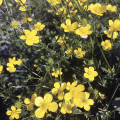Aquatic Plant Identification
Common Problem Plants
Plant Growth Forms
Aquatic plants can be generally classified into two groups. The algae are primitive plants that have no true roots, stems, or leaves, and do not produce flowers or seeds. The higher, more advanced group is the vascular plants, which usually have roots, stems, and leaves, and produce flowers and seeds.
The algae come in many forms but can be generally classified as
- planktonic – microscopic simple plants (not all are true plants) suspended in the water or floating on the surface as “scums,”
- filamentous and colonial – long strands, mats, clumps, or webs of algae that may start growing from the pond bottom and then rise to the surface to form mats, and
- macroalgae – a more advanced group that resembles vascular plants in growth habits.
The vascular plants typically exhibit one or more of three potential growth forms—submersed, emergent, or floating—and are often categorized using these criteria.
Submersed plants spend their entire life cycles at or below the surface of the water, although the flower parts of the plants may extend above the surface of the water. Usually the plants are rooted in the soil, but masses of plants may tear loose and float free in the water. Some submersed plants may appear to be emergent or floating plants, particularly when support structures for flowers are present. Some of the most noxious aquatic plant species are submersed.
Emergent plants are rooted in the bottom soil, and their leaves, stems, and flowers extend above the surface of the water. Many can grow in both aquatic and terrestrial environments. These plants are rigid and do not require the water for support. Many emergent plants may appear as submersed plants during the early growing season before they “top out,” and a few species may remain submersed indefinitely. In addition, a few may form extensive floating mats and, therefore, appear to be floating plants. Emergent plants are typically marginal except in water bodies that have extensive shallow water, or where they form mats that extend out to deeper water.
Floating plants include both free-floating plants not rooted or attached to the bottom soil and floating-leaf plants with roots that attach to the bottom, stems that extend toward the surface, and leaves that float on the surface. A few species may mature to have leaves that extend well above the surface, making them appear more like emergent plants. Likewise, some species of floating plants may appear to be submersed plants during certain seasons and growth stages, or under certain environmental conditions.
There are many species and subspecies, and accurate identification is critical for selecting a control method. A photo guide to the species common in Mississippi is in the Managing Mississippi Ponds and Small Lakes.pdf.
Publications
News
Whether you have a large lawn, field, or pasture, you’ve probably had to deal with pesky weeds.
Having “stickers” in your yard can be quite the nuisance. Stumbling upon a patch of stickers while walking barefoot is a painful experience. Plus it’s painful for your four-legged family members! Formally known as lawn burweed, these winter annuals are no fun to deal with.
The Dicamba Applicator Training required for individuals who plan to apply dicamba herbicide products in Xtend cropping systems is open online and scheduled at several sites across Mississippi.
The online modules are available at http://auxintraining.com.
The face-to-face workshops will be March 16-17 in Tunica, Coahoma, Hinds, Lee and Washington counties.



